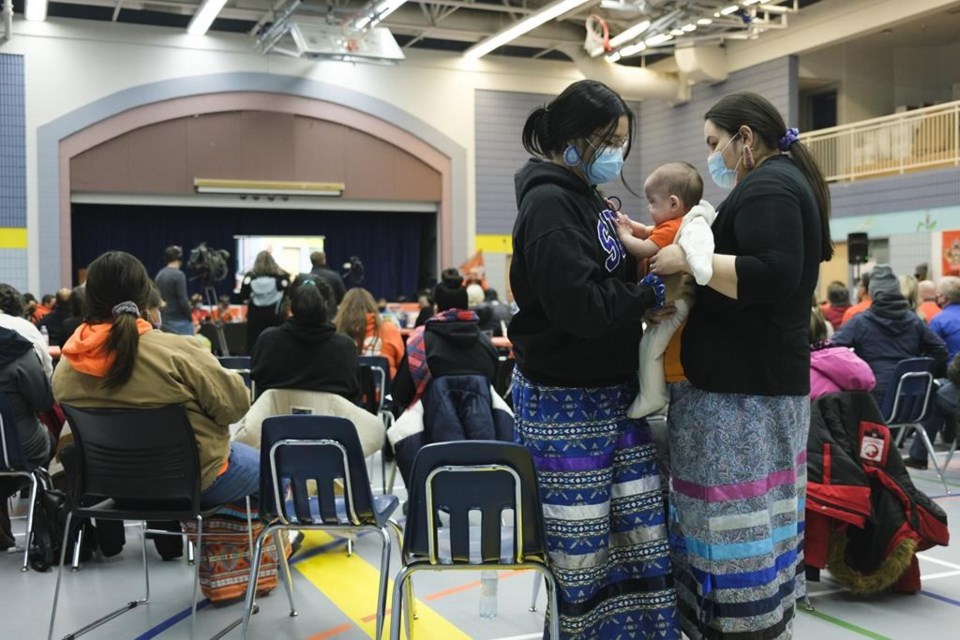KEESEEKOOSE FIRST NATION ÔÇö A First Nation in eastern Saskatchewan says it has found 54 potential graves believed to hold the remains of children who attended two former residential schools.
Members of the Keeseekoose First Nation held each other and wept Tuesday as photos were revealed one by one of the locations from a ground-penetrating radar search. 
The photos resembled the stories elders in the community have passed on for generations, but project leader Ted Quewezance said now the world will believe it, too. 
"It was not that they could not hear, but they did not believe our survivors," Quewezance said.
The graves were discovered on the grounds of the St. Philip's and Fort Pelly residential schools on the First Nation's land near Kamsack, near the Manitoba boundary about 265 kilometres northeast of Regina. Both were run by the Catholic Church.
There were 42 ground-penetrating radar hits at the Fort Pelley site and another 12 at St. Philip's school.
"We never expected anything up at St. Phillip's hill. That stunned the community," Quewezance said.
"We have a residential school monument there. We have gatherings there. In our culture and traditions it's very bad for us to be stepping over graves, and most of us probably ended up stepping on where those bodies were."
The Fort Pelley site was less of a surprise. Quewezance, who is a former chief and has spoken about the abuse he experienced at the schools, said there were many stories related to the area.
He said he believes there are children buried there because of headstones that once stood there, many for unnamed children. The community wants to know what happened to the headstones and why there were removed. 
It took searchers two months to survey just under three hectares of land. They used oral stories from elders to guide them, but had to stop due to snow. There are another four hectares to go. 
Quewezance said more graves are likely to be discovered.
Chief Lee Kitchemonia said it will be tough for residents knowing there are unmarked graves where people walk every day.
"These could potentially be murdered children, hidden," Kitchemonia said. 
Keeseekoose First Nation is working with the RCMP, the Truth and Reconciliation Commission and the Roman Catholic Archdiocese of Regina to obtain historical records of those who went to the schools. 
Fort Pelly school ran from 1905 to 1913. The National Centre for Truth and Reconciliation says the principal was fired in 1911 after it was reported he was drunk and threatening everyone at the school. 
The Truth and Reconciliation Commission found St. Philip's school, open from about 1927 to 1969, had a widespread problem with sexual and physical abuse, which led to the dismissal of a school supervisor during the school's final decade.
The commission, which documented stories from survivors and issued a final report in 2015, has a record of two student deaths at St. Philip's and two at Fort Pelly.
In a room full of community members who stood near photographs of former schoolchildren, Kitchemonia called on Pope Francis to visit residential schools in sa╣·╝╩┤½├¢.┬á
"I would like to send an invitation out to the Pope to come to the scene of the crime. Because that's what it is. It's a crime ... and he needs to come to sa╣·╝╩┤½├¢."
An estimated 150,000 First Nations, Inuit and M├®tis children attended residential schools. The commission documented at least 4,100 deaths.
Crown-Indigenous Relations Minister Marc Miller, who appeared Tuesday by video, said it was important he witness "sa╣·╝╩┤½├¢'s ongoing shame in the face of these findings."
"To survivors and your families ÔÇö I believe you and sa╣·╝╩┤½├¢ believes you," Miller said.
Saskatchewan Premier Scott Moe posted on social media that the province was mourning with the Keeseekoose people.
Mary Culbertson, Saskatchewan's treaty commissioner who is from Keeseekoose, said residential schools are a reflection of broken treaties that promised a schoolhouses and teachers on reserves.
"We inherited a legacy that we didn't want."
The Indian Residential Schools Resolution Health Support Program has a hotline to help residential school survivors and their relatives suffering trauma invoked by the recall of past abuse. The number is 1-866-925-4419.
This report by The Canadian Press was first published Feb. 15, 2022.
ÔÇö With files from Kelly Malone in Winnipeg
Mickey Djuric, The Canadian Press



